 Like so many things in Japanese culture, if you explore a little bit below the surface understanding of any topic, there is a whole world to discover… this is true for sushi, kimono and of course, sake, too.
Like so many things in Japanese culture, if you explore a little bit below the surface understanding of any topic, there is a whole world to discover… this is true for sushi, kimono and of course, sake, too.
I had this same feeling when I was recently invited by the local community here in Minami Uonuma to make “New Year’s decorations”. I was envisioning something like a christmas ornament crafting session at the local community center with ribbons and glue. I arrived at the community center however to find several bundles of rice straw outside and what we would really be making started to come into clearer focus.
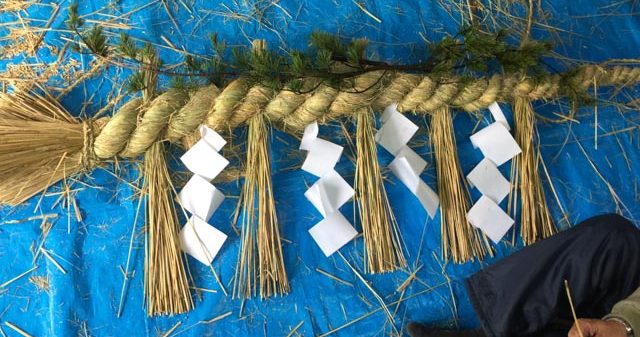
I soon understood we would be crafting our own Shimenawa (標縄) to decorate a local shinto shrine in preparation for New Years. Shimenawa is something I had seen dozens of times before, but never thought much about. It is a type of rope woven by hand out of rice straw. The ropes can range from thin to very think and they are used to delineate sacred or pure areas at a shinto shrine. These ropes are also used to signal a space that can house or enshrine a shinto deity, so you see these ropes adorning entrances to shrines and also wrapped around Yorishiro (依り代) or objects such as special trees or rocks that are capable of attracting and housing shinto gods. Our community would be working throughout the morning to create different types of Shimenawa for a small local shrine dedicated to Inari, the god of foxes, rice and sake.
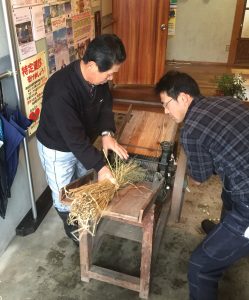 The first step in making our own Shimenawa was to soften the rice straw to make it pliable. To this end, an an old fashioned press appeared from storage. this was a machine that looked like it had seen decades of Shimenawa production. A hand crank was turned and the rice fed through to crush it a bit and soften the fibers.
The first step in making our own Shimenawa was to soften the rice straw to make it pliable. To this end, an an old fashioned press appeared from storage. this was a machine that looked like it had seen decades of Shimenawa production. A hand crank was turned and the rice fed through to crush it a bit and soften the fibers.
We all took turns running the crank and I even had a go. One of the farmers told me with out this machine we would be beating the rice with a stick to soften it. This seemed much better!
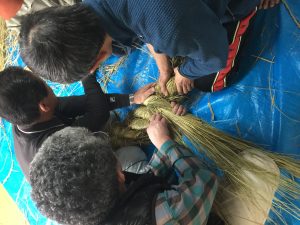 After softening, the rice was brought into the work room and everyone sat down and started working. I first just watched and was amazed to see ropes and other woven decorations begin to appear.
After softening, the rice was brought into the work room and everyone sat down and started working. I first just watched and was amazed to see ropes and other woven decorations begin to appear.
The method for making the rope boils down to rolling multiple bundles of rice straw between the palms of your hands to twist it in one direction, and then braiding the bundles in the other direction. This creates a strong rope that won’t come undone.
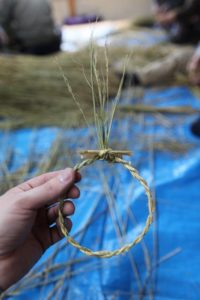 After a quick lesson, I was trying to make my own Shimenawa. My first two tries were a failure with my rope immediately unraveling, but after a bit more instruction, I figured out the trick and soon had a two ply thin rope of my own creation! I tied the rope into a circle to make a wreath.
After a quick lesson, I was trying to make my own Shimenawa. My first two tries were a failure with my rope immediately unraveling, but after a bit more instruction, I figured out the trick and soon had a two ply thin rope of my own creation! I tied the rope into a circle to make a wreath.
My next challenge was to make a kind of carrot-shaped woven decoration using a three ply rope that is hung on a shinto shrine doorframe. Working with three ply was more difficult, but I got it to work and made a smaller, messier version than the pros!
After a few hours of everyone twisting and weaving, it was time to bring all the finished products to the shrine. And the finished products were impressive. There was a large rope to hang over the entrance to the shrine and smaller ropes for the doorframe. Also, a rope was wrapped around a beautiful and huge yorishiro tree next to the shrine. The ropes were all adorned next with shide (紙垂), white zigzag paper streamers that are used to ward off evil spirits and that help demarcate a sacred space.
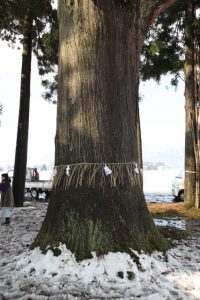
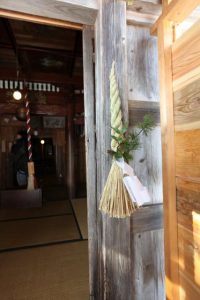
All this was done in a few hours, but I felt I had learned so much in this short time. It was such a rare experience to learn this craft first hand from Niigata locals.







